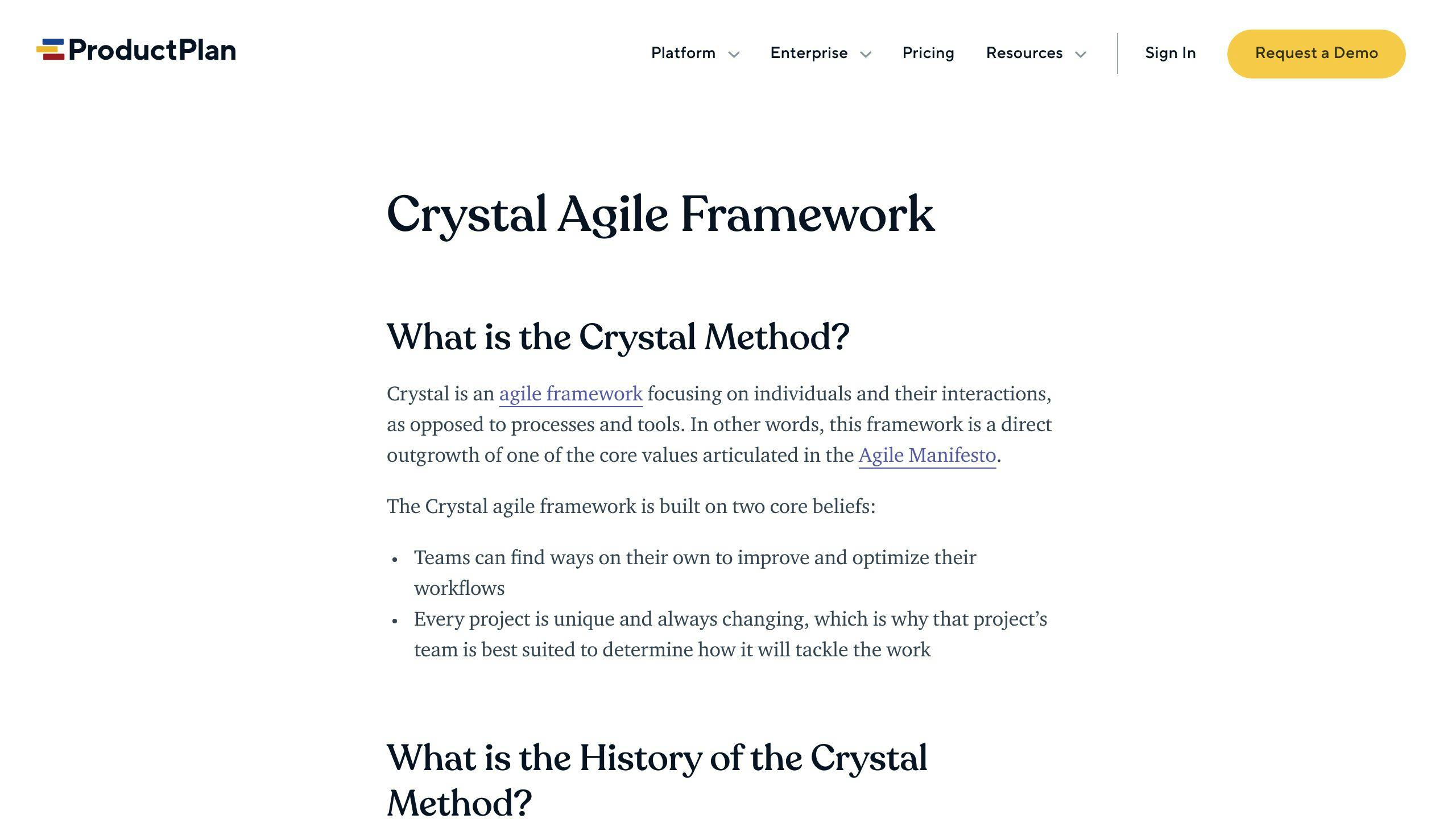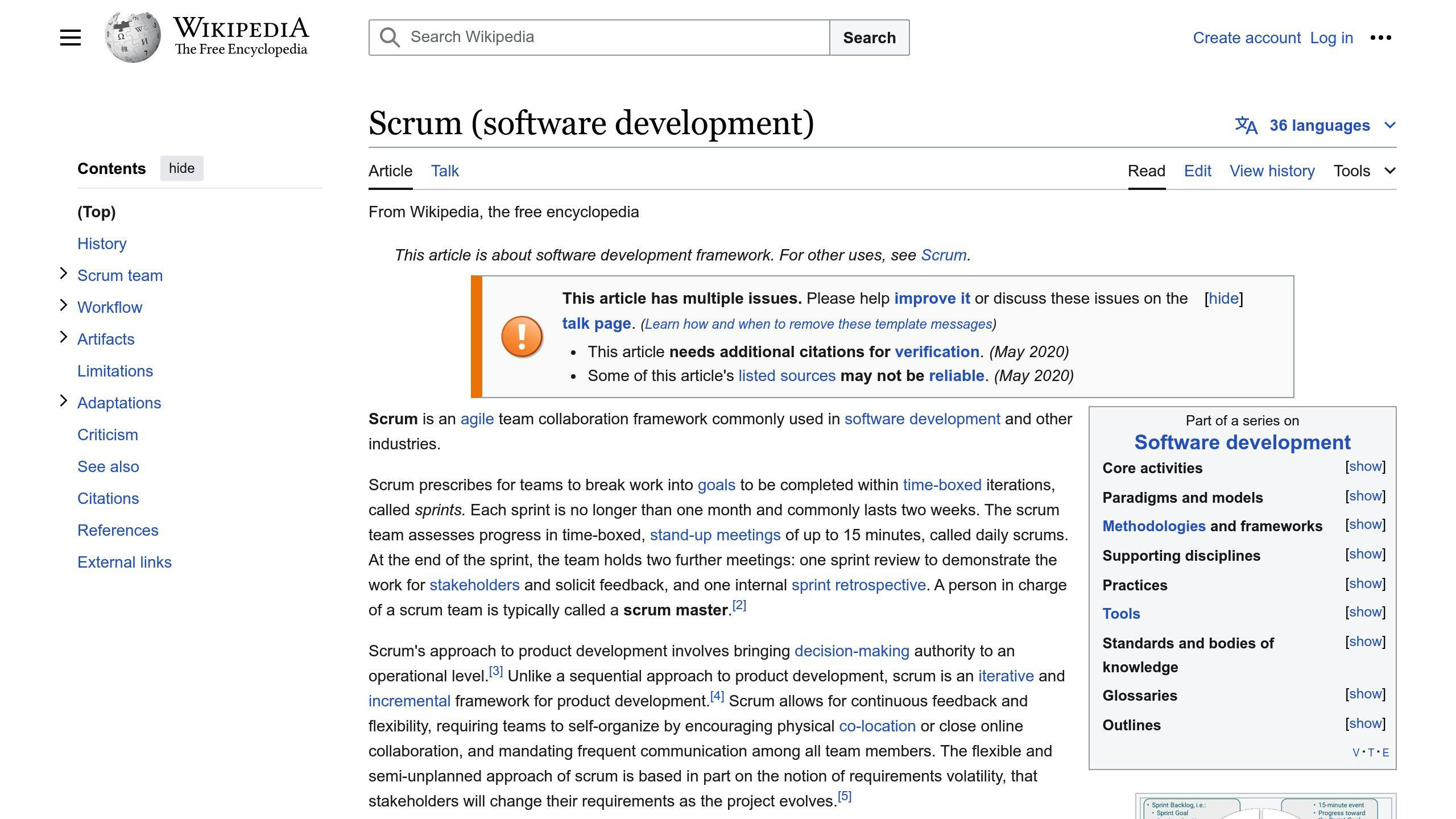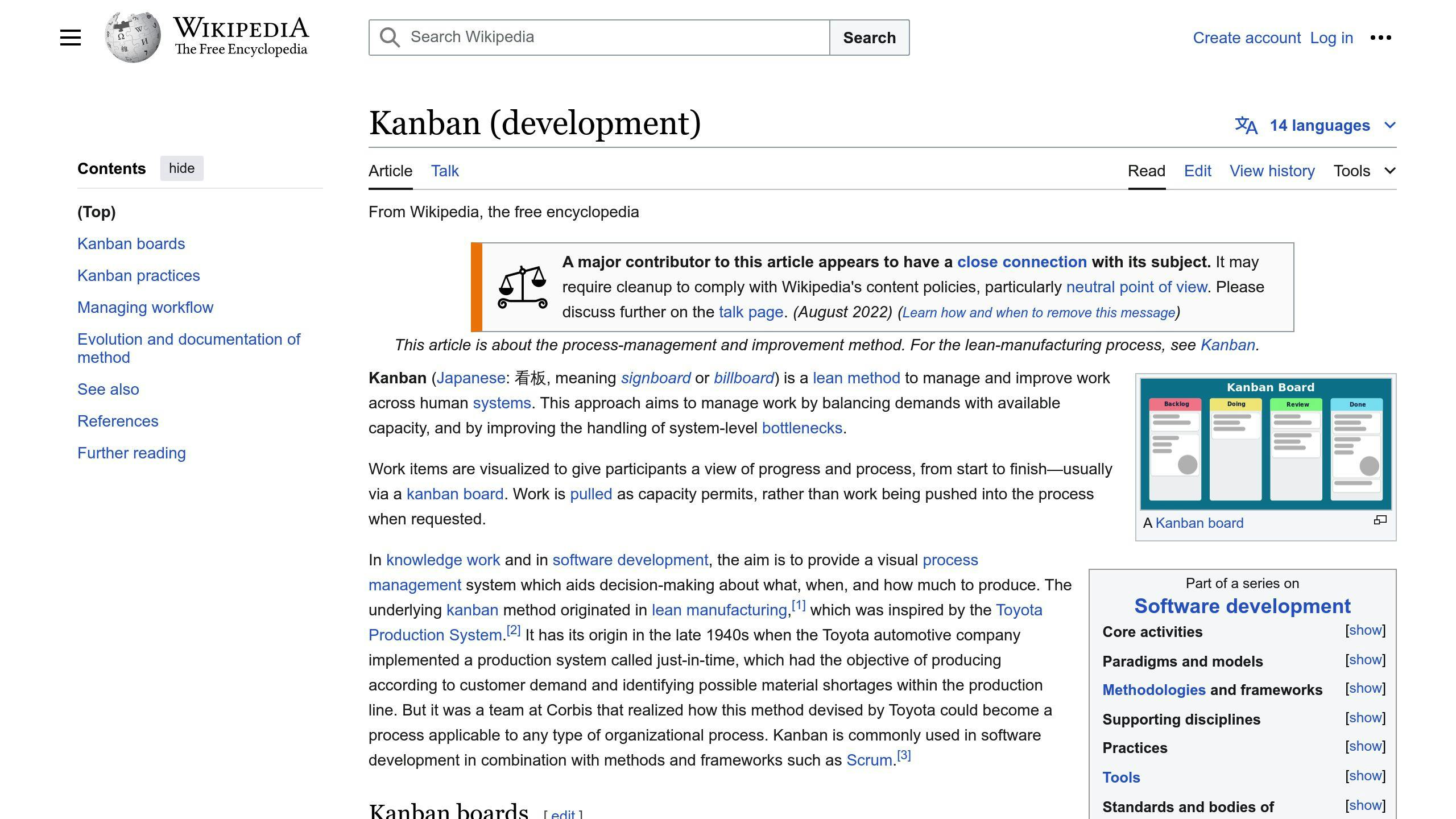Crystal Methodology is an Agile framework tailored for software development projects. It emphasizes team collaboration, frequent delivery, and continuous improvement. Crystal offers flexibility by providing guidelines instead of rigid rules, allowing teams to adapt processes based on project complexity and team size.
Key Benefits of Crystal Methodology:
- Flexibility: Customize processes to specific project needs
- Collaboration: Foster open communication and teamwork
- Early Delivery: Gather user feedback early and iterate on the MVP
- Scalability: Accommodate growing teams and increasing complexity
- Quality Focus: Maintain high standards throughout development
Crystal Methodology Principles:
- Frequent Delivery
- Reflective Improvement
- Osmotic Communication
- Personal Safety
- Focus
- Easy Access to Expert Users
- Technical Environment
Crystal Variations:
| Variation | Description |
|---|---|
| Crystal Clear | For small teams (1-6 people) on object-oriented projects |
| Crystal Yellow | For larger projects, with a focus on coordination |
| Crystal Orange | For larger projects with additional complexities |
| Crystal Red | For large-scale projects with significant risks and structure |
Comparison with Scrum and Kanban:
| Aspect | Scrum | Crystal | Kanban |
|---|---|---|---|
| Approach | Prescriptive framework | Flexible, tailored processes | Workflow visualization |
| Roles | Defined roles | Self-organizing teams | Self-organizing teams |
| Ceremonies | Structured ceremonies | Minimal ceremonies | No prescribed ceremonies |
| Processes | Iterative Sprints | Adapted to project needs | Continuous flow |
| Documentation | Emphasis on artifacts | Minimal documentation | Workflow visualization |
Crystal Methodology is an excellent choice for startups seeking an Agile approach that combines flexibility, collaboration, and a focus on delivering value for Minimum Viable Products (MVPs).
Related video from YouTube
Crystal Methodology Principles

Crystal Methodology is built on a set of principles that emphasize the importance of people, communication, and flexibility in software development. These principles guide the development process, ensuring that teams deliver high-quality products that meet customer needs.
Core Principles
The core principles of Crystal Methodology are designed to foster a collaborative and flexible development environment. These principles include:
| Principle | Description |
|---|---|
| Frequent Delivery | Deliver a working product quickly and regularly to ensure that customers receive a functional product and provide feedback for future development. |
| Reflective Improvement | Continuously reflect on and improve the development process to ensure that it remains effective and efficient. |
| Osmotic Communication | Encourage open and transparent communication among team members to facilitate collaboration and knowledge sharing. |
| Personal Safety | Create a safe and respectful environment where team members feel comfortable sharing their ideas and opinions without fear of criticism or judgment. |
| Focus | Ensure that the team remains focused on the project goals and objectives, avoiding distractions and minimizing multitasking. |
| Easy Access to Expert Users | Provide easy access to expert users and stakeholders to ensure that the product meets their needs and expectations. |
| Technical Environment | Establish a technical environment that supports the development process, including automated testing, configuration management, and continuous integration. |
Crystal Variations
Crystal Methodology offers different variations, each tailored to specific project sizes and complexities. These variations include:
| Variation | Description |
|---|---|
| Crystal Clear | Suitable for small teams (1-6 people) working on object-oriented projects where communication and collaboration are crucial. |
| Crystal Yellow | Intended for larger projects where team collaboration and communication remain essential, with a focus on adapting processes for better coordination and efficiency. |
| Crystal Orange | Aimed at larger projects with additional complexities, introducing more formalized processes while maintaining flexibility. |
| Crystal Red | Tailored for larger-scale projects with significant complexity and risks, involving more structure and discipline while maintaining flexibility. |
These variations ensure that Crystal Methodology can be applied to a wide range of projects, from small startups to large enterprises, and can be adapted to meet the unique needs of each project.
Crystal vs. Other Agile Methods
Crystal and Scrum

Crystal and Scrum are both Agile frameworks, but they have different approaches. Scrum is a more structured framework with defined roles and ceremonies. Crystal, on the other hand, is more flexible and adaptable to project needs.
| Aspect | Scrum | Crystal |
|---|---|---|
| Approach | Prescriptive, follows a set framework | Flexible, tailored to project and team |
| Roles | Defined roles (Scrum Master, Product Owner, Development Team) | No defined roles, team self-organizes |
| Ceremonies | Structured ceremonies (Sprint Planning, Daily Standup, Sprint Review, Retrospective) | Minimal ceremonies, focus on direct communication |
| Processes | Follows a structured, iterative process (Sprints) | Processes adapted based on project complexity and team size |
| Documentation | Emphasis on artifacts (Product Backlog, Sprint Backlog) | Minimal documentation, favors osmotic communication |
Scrum's structured approach can be beneficial for teams that require a well-defined process and clear roles. However, Crystal's flexibility allows teams to adapt to changing requirements and project complexities more easily.
Crystal and Kanban

Both Crystal and Kanban prioritize flexibility and continuous delivery, but their approaches differ. Kanban focuses on visualizing the workflow, limiting work in progress (WIP), and optimizing the flow of work. Crystal, on the other hand, emphasizes team communication, collaboration, and adapting processes to project needs.
| Aspect | Kanban | Crystal |
|---|---|---|
| Focus | Workflow visualization and WIP limits | Team communication and collaboration |
| Processes | Continuous flow, pull-based system | Tailored processes based on project complexity |
| Roles | No defined roles, self-organizing teams | No defined roles, team self-organizes |
| Ceremonies | No prescribed ceremonies | Minimal ceremonies, focus on direct communication |
| Adaptability | Adapts to existing workflows | Adapts processes to project and team needs |
Kanban's strength lies in its ability to optimize workflows and improve efficiency by limiting WIP and visualizing bottlenecks. Crystal, however, excels in fostering effective team communication and collaboration, which can be particularly beneficial for projects with complex requirements or diverse team skillsets.
While Kanban can be applied to various workflows, Crystal is specifically designed for software development projects, offering a more holistic approach that considers the entire project environment and team dynamics.
Crystal Team Structure
Crystal Methodology emphasizes the importance of a well-structured team to ensure the successful delivery of Agile MVP projects. The team structure in Crystal is designed to facilitate collaboration, communication, and iterative progress.
Roles and Responsibilities
In a Crystal project, various roles contribute to the MVP development process. These roles can be categorized into two types: real roles and virtual roles.
Real Roles
| Role | Description |
|---|---|
| Executive Sponsor | Provides strategic vision, ensures project alignment with organizational goals, and secures resources. |
| Ambassador User | Represents end-users, provides feedback, and ensures that the developed software meets user needs. |
| Lead Designer | Oversees the project's technical design, ensures architecture meets requirements, and guides the development team. |
| Programmer/Developer | Translates requirements into working software, collaborates with the team, and ensures software quality. |
Virtual Roles
| Role | Description |
|---|---|
| Business Expert | Provides domain knowledge, confirms priorities, and ensures that the project aligns with business objectives. |
| Technical Writer | Creates documentation, user manuals, and guides to support the project. |
| Tester | Ensures software quality, identifies defects, and collaborates with developers to resolve issues. |
Enhancing Teamwork
The roles within Crystal facilitate collaboration, communication, and the project's iterative progress. The team structure encourages:
- Osmotic Communication: Team members share information and experiences, ensuring that everyone is informed and aligned.
- Iterative Progress: The team works in iterations, delivering working software in each cycle, and incorporating feedback to improve the product.
- Collaborative Decision-Making: Team members collectively make decisions, ensuring that everyone is committed to the project's goals and objectives.
By embracing Crystal's team structure and roles, Agile MVP projects can benefit from improved collaboration, communication, and iterative progress, ultimately leading to the delivery of high-quality software products that meet user needs.
Implementing Crystal for MVPs
Implementing Crystal Methodology for Agile MVP development involves a structured approach to ensure successful project delivery. This section will guide startups on how to implement Crystal Methodology steps, from project initiation to delivery, for developing an MVP.
Crystal Process Overview
The Crystal project cycle consists of three iterative cycles:
| Cycle | Description |
|---|---|
| Project Cycle | Set project vision, form team, and establish initial project plan |
| Delivery Cycle | Deliver working software in each iteration, incorporating feedback |
| Iteration Cycle | Refine project plan and deliver incremental software updates |
Crystal Methodology incorporates workshops at the beginning and end of each iteration cycle to facilitate team reflection, process improvement, and adaptation to changing project requirements.
Crystal Practices for MVPs
Several practices make Crystal Methodology effective for MVP development:
- Osmotic Communication: Encourage team members to share information and experiences, ensuring everyone is informed and aligned.
- Frequent Releases: Deliver working software in each iteration, incorporating feedback to improve the product.
- Reflective Improvement: Hold regular workshops to reflect on project progress, identify areas for improvement, and adapt the methodology accordingly.
By adopting these practices, startups can ensure their MVP development projects benefit from improved collaboration, communication, and iterative progress, ultimately leading to the delivery of high-quality software products that meet user needs.
sbb-itb-4cff84e
Pros and Cons of Crystal
Crystal Methodology has its advantages and disadvantages when applied to Agile MVP development. Understanding these points is crucial for startups to make informed decisions about adopting Crystal for their projects.
Comparison Table
| Advantages | Challenges |
|---|---|
| Customizable: Tailors to project needs | Lack of structure: May not suit teams needing guidance |
| Team collaboration: Emphasizes communication and teamwork | High team self-management: Requires team members to manage themselves |
| Early and frequent delivery: Delivers MVP quickly | Scaling complexity: Adds complexity when scaling to larger teams |
| Technical excellence: Focuses on delivering high-quality software | Limited documentation: May pose risks due to minimal documentation |
| Continuous improvement: Encourages learning and growth | Regulatory limitations: May not be suitable for projects with strict regulations |
| Osmotic communication: Fosters open communication and feedback | Distributed team challenges: Can be difficult to implement for distributed teams |
By weighing these advantages and challenges, startups can determine whether Crystal Methodology is the right fit for their Agile MVP development projects.
Scaling Crystal
Adapting for Growth
As your team grows, adapting Crystal Methodology becomes crucial. Here are some recommendations for scaling Crystal effectively:
Embracing Variants
Crystal offers different variants like Crystal Clear, Crystal Yellow, and Crystal Orange, designed for teams of varying sizes and complexities. As your team grows, transition to the appropriate variant that better aligns with your expanded scope and requirements.
Introducing Specialized Roles
While Crystal promotes self-organizing teams, larger projects may benefit from introducing specialized roles like Project Coordinators or Technical Leads. These roles can facilitate communication, decision-making, and knowledge sharing across multiple teams.
Implementing Scaling Patterns
Leverage scaling patterns like Scrum of Scrums or Nested Teams to coordinate work across multiple teams. These patterns help maintain transparency, alignment, and collaboration as the organization scales.
Enhancing Communication Channels
Establish robust communication channels, such as regular meetings, collaboration tools, and knowledge-sharing platforms. This ensures that information flows seamlessly across teams, mitigating the risks associated with scaling.
Automating Processes
Invest in automation tools for continuous integration, testing, and deployment. Automation streamlines processes, reduces manual effort, and ensures consistency as the codebase and team size grow.
Modular Architecture
Adopt a modular software architecture that allows teams to work independently on different components. This approach promotes parallel development, reduces dependencies, and facilitates scaling.
Training and Coaching
As the team expands, ensure that new members receive proper training and coaching on Crystal principles and practices. This helps maintain a consistent understanding and application of the methodology.
Continuous Improvement
Continuous improvement is a core principle of Crystal Methodology, and it becomes even more crucial as startups scale their Agile MVP development. Here are some tips to sustain a culture of reflection and adaptation:
Regular Retrospectives
Facilitate regular retrospective meetings to identify areas for improvement. Encourage open discussions and gather feedback from all team members, fostering a culture of transparency and continuous learning.
Experimentation
Encourage teams to experiment with new practices, tools, or techniques that could enhance their workflow. Create a safe environment where failures are treated as learning opportunities, promoting innovation and continuous improvement.
Metrics and Analysis
Establish a set of relevant metrics to measure team performance, product quality, and customer satisfaction. Analyze these metrics regularly to identify areas for improvement and make data-driven decisions.
Knowledge Sharing
Foster an environment of knowledge sharing by encouraging team members to document lessons learned, best practices, and insights. This knowledge base can be invaluable for continuous improvement and onboarding new team members.
External Feedback
Actively seek feedback from customers, industry experts, and other stakeholders. External perspectives can provide valuable insights and help identify blind spots or areas for improvement that may be overlooked internally.
By following these practices, startups can effectively scale their Crystal Methodology implementation while maintaining the agility, adaptability, and continuous improvement mindset that drives successful Agile MVP development.
Crystal Success Stories
Crystal Methodology has been successfully implemented in various startups, leading to improved agility and customer satisfaction. In this section, we'll explore real-world examples of startups that have leveraged Crystal Methodology for successful MVP development.
Small Team MVPs
| Startup | Team Size | Crystal Variant | MVP Development Time | Outcome |
|---|---|---|---|---|
| Mobile App for Personal Finance | 4 | Crystal Clear | 3 months | Functional MVP with positive user feedback |
| Web Platform for Booking Travel Accommodations | 6 | Crystal Clear | 4 months | Functional MVP with positive user reviews |
Scaling with Crystal
| Startup | Initial Team Size | Initial Crystal Variant | Scaling Team Size | Scaling Crystal Variant | Outcome |
|---|---|---|---|---|---|
| Cloud-based Project Management Tool | 10 | Crystal Orange | 20 | Crystal Red | Maintained agility and adaptability while scaling up |
| Machine Learning-based Chatbot for Customer Support | 15 | Crystal Yellow | 30 | Crystal Orange | Maintained agility and adaptability while scaling up |
These success stories demonstrate the effectiveness of Crystal Methodology in enabling startups to develop successful MVPs and scale up their development process while maintaining agility.
Conclusion
Key Benefits of Crystal Methodology
Crystal Methodology offers several key advantages for startups developing Agile MVPs:
| Benefit | Description |
|---|---|
| Flexibility | Tailor processes to specific project needs, team size, and complexity |
| Collaboration | Foster open communication, teamwork, and innovation |
| Early Delivery | Gather user feedback early and iterate on the MVP |
| Scalability | Accommodate growing teams and increasing project complexity |
| Quality Focus | Maintain high-quality standards throughout the MVP development process |
Why Choose Crystal Methodology?
Crystal Methodology is an excellent choice for startups seeking an Agile approach that combines flexibility, collaboration, and a focus on delivering value. Its unique ability to adapt to different team sizes, project complexities, and evolving requirements makes it well-suited for the dynamic and fast-paced startup environment.
By embracing Crystal's core principles, startups can develop MVPs that truly resonate with their target audience, validate their ideas, and iterate towards a successful product launch. Moreover, Crystal's scalability ensures that as the startup grows, the development process can seamlessly transition to accommodate larger teams and more complex projects.
In summary, Crystal Methodology is an ideal choice for startups seeking a lightweight yet powerful Agile methodology that empowers teams to deliver high-quality MVPs while remaining responsive to changing market demands.
FAQs
What is the difference between Crystal Agile and Scrum?
Crystal Agile and Scrum are both Agile methodologies, but they have different approaches. Scrum is a more structured framework with defined roles and practices. Crystal Agile, on the other hand, is more flexible and customizable based on project needs.
Here's a brief comparison:
| Methodology | Structure | Roles | Approach |
|---|---|---|---|
| Scrum | Structured | Defined roles (Scrum Master, Product Owner, Development Team) | Follows a set framework |
| Crystal Agile | Flexible | No defined roles, team self-organizes | Tailors to project needs |
In summary, Scrum provides a more rigid framework, while Crystal Agile offers a more adaptable approach to Agile development.
